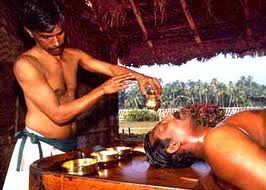This ancient healing system from India stresses the mind/body relationship in the maintenance of good health. As in other Asian medical practices, a balance of vital energy, in the case, prana, is considered the key. The system is based on balancing three basic life forces or doshas-vata, responsible for all movement in the body, pitta, which controls digestion and energy production and kapha, responsible for all movemont in the body's structure and stability. Illness occurs when any of the doshas is out of sync; individuals must know their dominant doshas and follow a diet and lifestyle that keeps it balanced with the others.
ORIGINS
Ayurveda, meaning the 'science of life and longevity' in Sanskrit, is believed to be about 5,000 years old, predating all other medical systems. The two classic Ayurveda text-books are more than 2,000 years old. Charaka Samhita, named for the person who was the ayurvedic counterpart of Hippocrates, outlines the principles of health maintenance and treatment of disease and Sushruta Samhita describes elaborate surgical procedures, including reconstructive plastic surgery, gallbladder removal and other operations that most people consider modern.
Ayurvedic medicine spread with the Hindu culture to Indonesia, Tibet and eventually to the West, where some of its principles were picked up by the ancient Greek physicians. As Buddhism developed, this healing system was carried to China and other Asian countries.
During the 1800s, the British banned all ayurveddic schools in India, replacing them with Western medical schools. For the next century, ayurvedic medicine was relegated to folk practices in rural areas. When India regained its independence in 1947, ayurvedic schools were again legalized. Today, there are 100 ayurvedic schools in India, equal in number to the Western ones and many Indian physicians incorporate both styles of medicine into their practices.
In recent years, Ayurveda has spread to the United States. Major clinics have been established in Lancester, Massachusetts and Albuquerque, New Mexico.
PRACTITIONERS
In India, Ayurvedic practitioners must undergo five to six years of training in a traditional ayurvedic medical school before they can treat patients. In the United States, this training is abbreviated into a short course of several months at an ayurvedic institute. Whichever training they have received, ayurvedic physicians are not licensed to practice medicine here, unless they are trained also in another discipline, such as traditional medicine, osteopathy or chiropractic.
WHEN IT IS USED
Unlike Western medicine, which comes into play when illness strikes, Ayurveda is incorporated into a person's lifestyle. It governs all aspects of life, such as diet, exercise and sexual practices. An ayurveda practitioner is consulted only to identify and correct an imbalance among the three life forces. At ayurveda clinics in the United States, patients are usually treated by both a Western and an ayurvedic physician.
HOW IT WORKS
Ayurvedic philosophy hold that each person is born with a particular ratio of doshas, with one dominating. This dominant dosha determines personality type and also influences one's susceptibility to certain illness. For example, pitta people tend to have fiery dispositions and are prone to developing high blood pressure and digestive disorders, so a pitta-related disease may be treated with a bland diet and numerous herbal remedies. Because the mind is seen as an intergral force in maintaining health and overcoming illness, meditation or yoga may also be employed.
WHAT TO EXPECT
An ayurvedic doctor begins by assessing the patient's dosha pattern. Pulses play a critical role in this assessment - a pratitioner feels pulse throughout the body, looking for dosha imbalances as reflected in the nature of a pulse. Seven types of body tissue - plasma, red blood cells, muscle, fat, bone, nerve and reproductive tissue - are also examined.
Ayurveda physicians do not focus on a specific disease or an organ system, but instead treat the entire body and mind. Purification to rid the body of toxins is an important part of treatment; methods may include sweat baths, enemas, nasal washes, bloodletting and oild massages. The practitioner will also recommend a specific diet, meditation or yoga routine and herbal remedies.
PRECAUTIONS
BEFORE AGREEING TO AYURVEDIC TREATMENTS, ASK ABOUT COSTS AND CANCELLATION POLICIES. SOME CLINICS ASK FOR ADVANCE PAYMENT AND REQUIRE TWO WEEK'S NOTICE OF CANCELLATION TO QUALIFY FOR A REFUND.



















7 comments:
i've tried ayurveda massage during my visit to Kerala India.. and all i can say is.. its greattt
nice blog.... salam kenal
Adza: here in kl pun ada.. kt area bangsar..
Mi'ing: tq.. salam kenal to u too.. keep in touch :-)
Excellent work
Wonderful blog post. I noticed this blog further more useful information. Thanks for sharing..
Ayurvedic Clinic
Panchakarma is ggod science keep edicating. -Sandeep Shah
Post a Comment